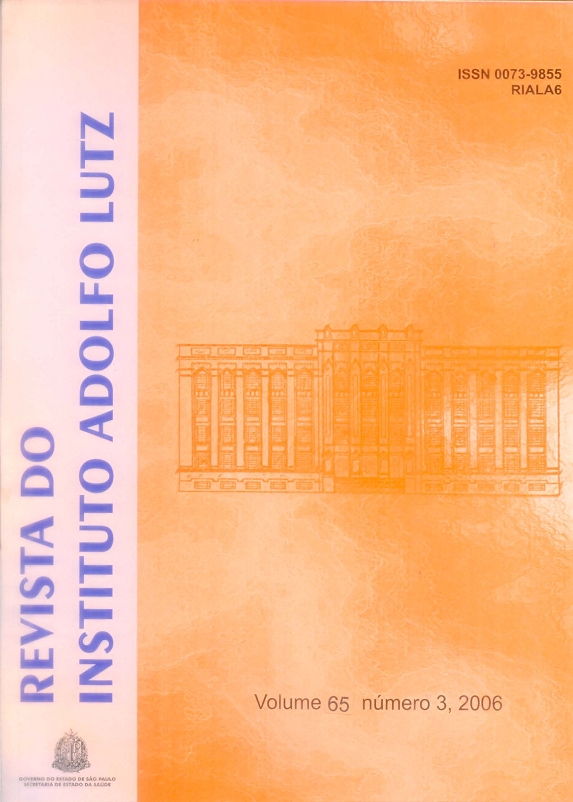Resumo
A doença celíaca é caracterizada pela intolerância ou hipersensibilidade à ingestão de prolaminas existentes no trigo, centeio, cevada e aveia. As proteínas do glúten do trigo são constituídas de aproximadamente 50% de prolaminas, denominadas gliadinas. O tratamento adotado para a doença celíaca é a dieta livre de glúten. A legislação brasileira determina que os produtos alimentícios industrializados devem apresentar a advertência da presença ou ausência de glúten na rotulagem. Duas amostras de referência estabelecidas em um estudo interlaboratorial e treze produtos alimentícios industrializados foram analisados para determinar a presença de glúten por meio de ensaio imunoenzimático comercial, ELISA técnica sanduíche, utilizando-se anticorpo monoclonal anti ω gliadina. O limite de detecção foi de 10 ppm (mg/kg). As amostras de referência revelaram resultados satisfatórios com boa exatidão. O glúten foi detectado nos produtos alimentícios que continham o referido componente declarado na rotulagem. O glúten não foi detectado nas amostras declaradas isentas de glúten, com exceção de uma amostra. O ensaio imunoenzimático utilizado discriminou as prolaminas não tóxicas apropriadas para os pacientes com doença celíaca, como os da farinha de arroz, milho, soja, mandioca, batata e batata doce, cujos ingredientes constavam nos dizeres de rotulagem. Os resultados apresentados evidenciam a viabilidade de uso de ELISA para a detecção de baixos teores de glúten em alimentos.Referências
1. Howdle PD, Blair GE. Molecular biology and coeliacdisease. Gut 1992; 33: 573-75.
2. Stern M, Ciclitia PJ, van Eckert R, Feighery C, Jansen FW, Mendez E, Mothes T, Troncone R, Wieser H. Analysis and clinical effects of gluten in coeliac disease. Eur J Gastroenterol Hepatol 2001; 13: 741-7.
3. Troncone R, Auricchio S. Gluten-sensitive enteropathy(celiac disease). Food Rev Int 1991; 7: 205-31.
4. Food Analysis Performance Assessment Scheme. Department for Enviroment, Food & Rural Affairs(DEFRA). Allergens Report 2705. Series 27. Round 05. February 2003. 29p. web: http://www.fapas.com e-mail: fapas@csl.gov.uk
5. Marsh MN. Gluten, major histocompatibility complex, and the small intestine. A molecular and immunobiologica pproach to the spectrum of gluten sensitivity (celiacsprue). Gastroenterol 1992; 102: 330-54.
6. Janatuinen EK, Kemppainen TA, Julkunen RJK, KosmaV-M, Maki M, Heikkinen M, Uusitupa MIJ. No harm fromfive year ingestion of oats in coeliac disease. Gut 2002;50: 332-35.
7. Lundin KEA, Nilsen EM, Scott HG, Loberg EM, Gjoen A, Bratlie J, Skar V, Mendez E, Lovik A, Kett K. Oats induced villous atrophy in coeliac disease. Gut 2003; 52: 1649-52.
8. Storsrud S, Olsson M, Arvidsson Lenner R, Nilsson L, Nilsson O, Kilander A. Adult coeliac patients do tolerate large amounts of oats. Eur J Clin Nutr 2003; 57: 163-9.
9. Brasil. Lei n. 8543 de 23 de dezembro de 1992. Determina a impressão de advertência em rótulos e embalagens de alimentos industrializados que contenham glúten, a fim de evitar doença celíaca ou síndrome celíaca. Diário Oficial da União, Brasília (1992 dez 24); Sec.1. Disponível em:http://e-legis.anvisa.gov.br/leisref/public/.
10. Brasil. Agência Nacional de Vigilância Sanitária. Aprova o Regulamento Técnico para Rotulagem de alimentos e bebidas embalados que contenham glúten. Resolução RDCn. 40, 8 fevereiro 2002. Diário Oficial da União, Brasília(2002 fev 13). Disponível em: http://www.anvisa.gov.br/legis/resol/2002/40_02rdc.htm.
11. Brasil. Lei n. 10.674 de 16 de maio de 2003. Obriga a quetodos os produtos alimentícios comercializados informem sobre a presença de glúten, como medida preventiva e de controle da doença celíaca. Diário Oficial da União, Brasília (2003 maio 19); Sec.1. Disponível em: http://www.anvisa.gov.br.
12. Hekkens W Th J M. Prolamin working group.Report aboutactions in relations to the FAO/WHO. In Working groupprolamin analysis and toxicity, 8, Belgium 3 - 5 november1993. Meeting. Tubigen, 1994 p 35-40.
13. Codex Alimentarius Commission, Proposed Draft Revised Standard for Gluten–free foods, Joint FAO/WHO Food Standards Program, 22nd Session, June 1997, ALINORM97/26 Appendix V.
14. Allmann M, Candrian U, Hofelein C, Luthy J. Polymerasechain reaction (PCR): a possible alternative to immunochemical methods assuring safety and quality offood: Detection of wheat-contamination in non-wheat food products. Z Lebensm Unters Forsch 1993; 196: 248-51.
15. Mendez E, Valdes I, Camafeita E. Analysis of glúten infoods by MALDITOF mass spectrometry. In: Chapman JR (editor): Methods in Molecular Biology. Totowa, NY: Human Press; 2000. pp. 355-67.
16. Scanlon MG, Sapirstein HD, Bushu KW. Evaluation of the precisin of HPLC for wheat- cultivar identification. Cereal Sci 1989; 66: 112-6.
17. Skerrit JH; Hill AS. Monoclonal antibody sandwichenzyme immunoassay for determination of gluten in foods. J Agric Food Chem 1990; 38: 1771-78.
18. Skerrit JH, Hill AS. Enzyme immunoassay for determination of gluten in foods: Collaborative Study, JAOAC. 1991; 74: 257-64.
19. Valdez I, Garcia E, Llorent M, Mendez E. Innovative approach to low-level gluten determination in foods usinga novel sandwich enzyme-linked immuno sorbent assayprotocol. Eur J Gastroenterol Hepatol 2003; 15: 465-74.
20. Mujico JR, Hernado A, Lombardia M, Benavides A, Silio V, Maki M, Kaukinen K, Collin P, Thorel L, Ryopy PH, Mendez E. Quantification of wheat, barley and ryecontamination in oat samples by real-time PCR. In: SternM ed Proceedings of the 19th Meeting of the Working Groupon Prolamin Analysis and Toxicity 30 September-3 October, 2004 Prague, Czech Republic 2005 Velag Wissenschaftliche Scripten 87-93.

Este trabalho está licenciado sob uma licença Creative Commons Attribution 4.0 International License.
Copyright (c) 2006 Rejane Weissheimer de Abreu, Sônia França Correia Barbosa, Jussara C. de M. Della Torre, Jaim Lichtig, Odair Zenebon
